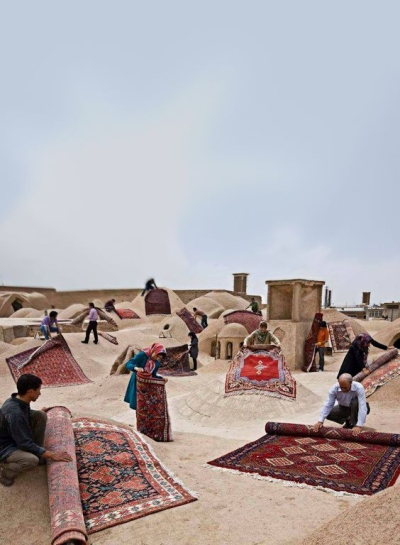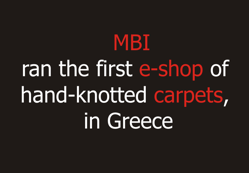Short story about the history of Handmade Carpets
The carpets are roughly divided in terms of designs into: floral, geometric and modern, while in terms of material into: wool, wool-silk and silk.
Wool is the most common material as it is the most resistant to use and dirt, it can be washed often without losing its properties and insulates very well against cold and heat, so you can leave the carpets laid all over time.
Silk, however, enhances the quality of every space while it has always been a symbol of wealth and is used from ancient times on carpets, ornaments and art for the clearest and most detailed recording of designs.
The technique of carpet weaving first appeared in ancient Persia and slowly spread to the surrounding countries, experiencing its greatest prosperity in the 16th and 17th centuries during the Safavid kingdom where Esfahan developed into a cultural center of the wider region.
The oldest carpet ever found is over 2,000 years old (so the art of carpet is much older) and was found frozen in Siberia. It is characteristic that its construction technique does not differ in anything from the technique of knitting carpets nowadays. Today it is exhibited in the Hermitage of St. Petersburg.
However, all the important museums of the world (London-New York-Berlin-Vienna-Istanbul-Tehran etc.) exhibit old famous carpets
Handmade rugs have always been an excellent investment, as quality rugs in particular retain or increase in value over time, while old antique rugs hold staggering sums at major global auctions such as Sotheby's & Christies.
While the old original designs evolved and mutated over time and their symbolism has often been lost, the colors continue to express something, so e.g. Red - the color of life and joy - is the most common color while white and black which symbolize mourning and sadness are not common. Blue as the color of the sky and infinity is preferred as the base color or edging color while green as the sacred color is rarely used as the faithful Muslims do not press it.
So carpets are not just colorful, in the past and today especially in home carpets they express hopes, fears and feelings, whether they use brown the color of fertility or blue-indigo the color of loneliness.
The old traditional countries whose carpets are named after the region they were built in are Iran (Persia), China, Afghanistan, Turkey, and all the southern regions of the former Soviet Union, Morocco and Nepal.
Newer countries like India, Pakistan, Kashmir name the carpets according to the plan.
Lately there has been a return to the roots, weaving carpets again with old traditional and often forgotten methods * and in old designs
eg carpets Aryana, Feraghan-Ziegler, Belgik, Ushak and Kandahar
something that happens even in modern rugs that have a special patina of the old like Loribaft rugs and Ziegler-modern rugs.
* traditional methods are eg hand twisted wool, vegetable dyes or stone washing
Wool is the most common material as it is the most resistant to use and dirt, it can be washed often without losing its properties and insulates very well against cold and heat, so you can leave the carpets laid all over time.
Silk, however, enhances the quality of every space while it has always been a symbol of wealth and is used from ancient times on carpets, ornaments and art for the clearest and most detailed recording of designs.
The technique of carpet weaving first appeared in ancient Persia and slowly spread to the surrounding countries, experiencing its greatest prosperity in the 16th and 17th centuries during the Safavid kingdom where Esfahan developed into a cultural center of the wider region.
The oldest carpet ever found is over 2,000 years old (so the art of carpet is much older) and was found frozen in Siberia. It is characteristic that its construction technique does not differ in anything from the technique of knitting carpets nowadays. Today it is exhibited in the Hermitage of St. Petersburg.
However, all the important museums of the world (London-New York-Berlin-Vienna-Istanbul-Tehran etc.) exhibit old famous carpets
Handmade rugs have always been an excellent investment, as quality rugs in particular retain or increase in value over time, while old antique rugs hold staggering sums at major global auctions such as Sotheby's & Christies.
While the old original designs evolved and mutated over time and their symbolism has often been lost, the colors continue to express something, so e.g. Red - the color of life and joy - is the most common color while white and black which symbolize mourning and sadness are not common. Blue as the color of the sky and infinity is preferred as the base color or edging color while green as the sacred color is rarely used as the faithful Muslims do not press it.
So carpets are not just colorful, in the past and today especially in home carpets they express hopes, fears and feelings, whether they use brown the color of fertility or blue-indigo the color of loneliness.
The old traditional countries whose carpets are named after the region they were built in are Iran (Persia), China, Afghanistan, Turkey, and all the southern regions of the former Soviet Union, Morocco and Nepal.
Newer countries like India, Pakistan, Kashmir name the carpets according to the plan.
Lately there has been a return to the roots, weaving carpets again with old traditional and often forgotten methods * and in old designs
eg carpets Aryana, Feraghan-Ziegler, Belgik, Ushak and Kandahar
something that happens even in modern rugs that have a special patina of the old like Loribaft rugs and Ziegler-modern rugs.
* traditional methods are eg hand twisted wool, vegetable dyes or stone washing






















